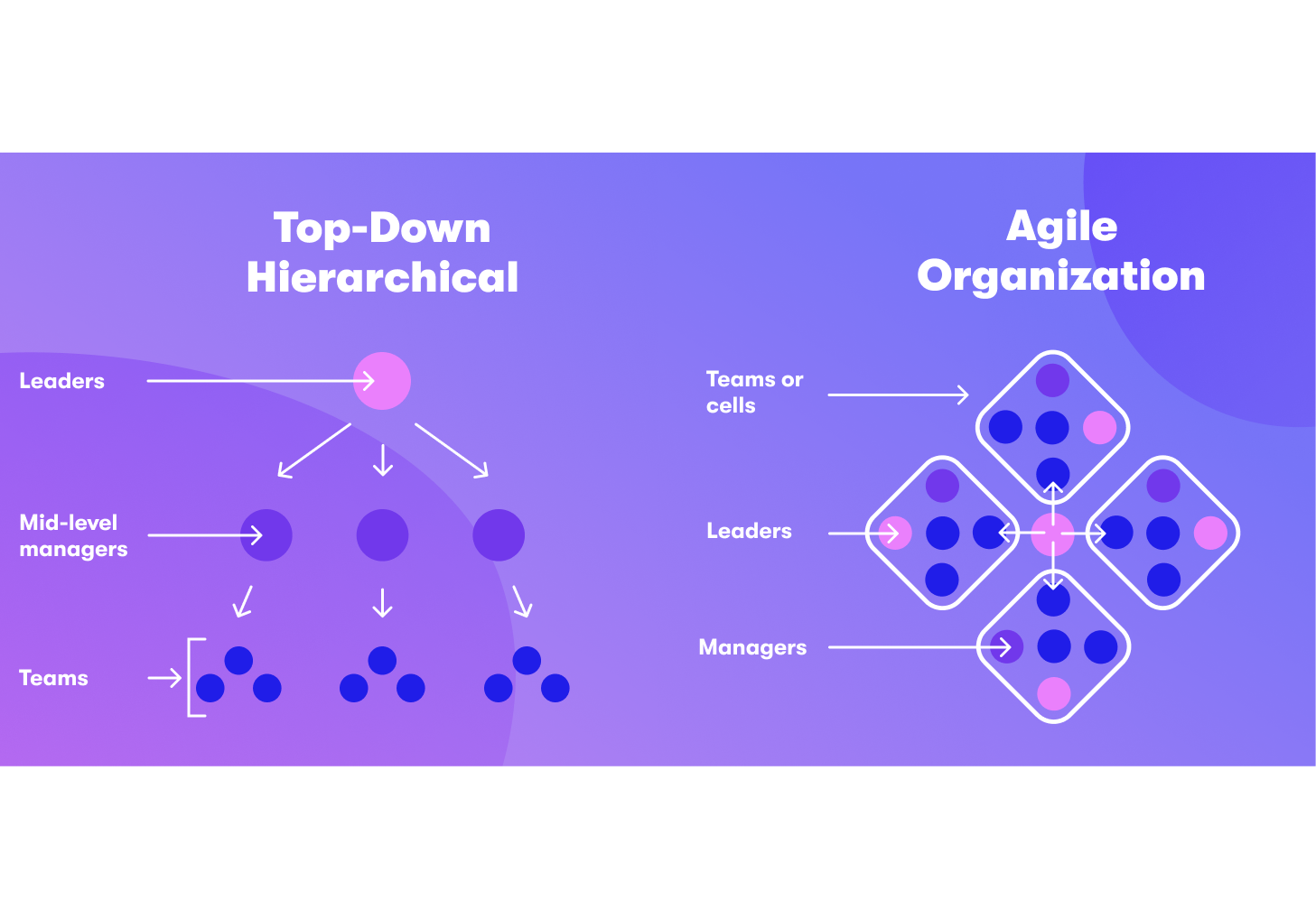What Is an Agile Organization?

Agile organizations rule
Leaders are starting to realize that the old ways of working are holding their employees back: Dictating working processes from the top down is no longer working for modern teams. So it’s time to switch it up. Traditional hierarchies are out, and agile organizations are officially in.
Agile organizations have revolutionized workplace norms by throwing away formalities and red tape, resulting in teams becoming more efficient, effective, and productive.
An agile mindset starts with leadership. Here’s everything you need to know.
What is an agile team?
An agile team is a group of people dedicated to the same project on a full-time basis. Every team is equipped with the necessary competencies and tools to concurrently complete the effort. Agile teams are typically cross-functional, focusing less on roles and responsibilities and more on the results. Multiple agile teams together make up an agile organization.
What is an agile organization?
Compared to a traditional organization built around a static and siloed hierarchy, an agile organization is a team network that operates through alignment, accountability, transparency, and collaboration. It implies that a company has a certain degree of flexibility to adapt to new ideas, concepts, and market changes.
Traditional hierarchical structures drool
The traditional organizational structure usually looks like a pyramid or a reversed funnel. The foundation comprises people who contribute value-adding work. They’re the ones who provide the services that bring the company growth. At the tippy-top of the pyramid, we have the executives in charge of the organization's overall success. In this structure, it’s traditionally held to be true that success lies in the leaders’ abilities to hold power, make decisions, and delegate tasks. Connecting both sides of the pyramid are the managers. They set deadlines and expectations for employees and report back to the executives. To limit interactions and distractions, information to employees is on a need-to-know basis.
What does a top-down hierarchical structure look like?
The traditional organizational structure usually looks like a pyramid or a reversed funnel. The foundation comprises people who contribute value-adding work. They’re the ones who provide the services that bring the company growth. At the tippy-top of the pyramid, we have the executives in charge of the organization's overall success. In this structure, it’s traditionally held to be true that success lies in the leaders’ abilities to hold power, make decisions, and delegate tasks. Connecting both sides of the pyramid are the managers. They set deadlines and expectations for employees and report back to the executives. To limit interactions and distractions, information to employees is on a need-to-know basis.
Why the old paradigm doesn’t work
For this structure to function, executives need to make decisions based on standardized status reports, collected data, and accountable persons. The consequence of this hierarchical system is that the over-simplification of information obscures vital organizational conclusions. This system results in decisions that don’t necessarily reflect the reality of the company and forces everyone else in the pyramid to work around layers of red tape and bureaucratic noise.

The structure of agile organizations
Agile organizations embrace a structure of adaptability and flexibility. They’re customer-centric and adopt a fast learning and decision cycle to build a network of empowered teams and individuals commonly driven by an overarching purpose.
What does an agile organization look like?
The structure of an agile organization is built around various teams grouped around joint missions. Those contributing to value-adding work are categorized in teams, sometimes called cells. These teams are cross-functional and fully autonomous, meaning that they have all the necessary skills to complete their tasks and decide how the work will be completed and by whom. And while their tasks may change over time, their goal is clearly set around the company mission.
Leadership still exists, but it’s centered around teams and managers. Leaders provide clear guidance and support to managers and people for the organization to succeed. They help create achievable goals and visions, as well as establish priorities and provide information. Most importantly, they trust that people will work to complete their tasks in whatever way they need.
Middle managers work alongside everyone else by helping teams with feedback, guidance, and approvals when needed. They are also there to encourage a healthy office environment, happy employees, and professional development.
Why go agile?
The world is constantly changing, and businesses are frequently confronted with the challenge of keeping pace with the rapid market shifts. This transformation is often complex for traditional structures because they are slower to adapt to new processes. On the other hand, agile organizations can bend to accommodate the changes and even use them to their advantage!
Characteristics of an agile organization
There are many different approaches to achieving organizational agility. Some companies are agile from the get-go, and others have to willingly make the transition either with full force or step-by-step. While differing in pace, scope, and approach, every agile organization embodies a few common traits.
🛍️ Customer focus - A customer-centered organizational system aims to understand its customers inside and out. Finding out pain points and needs throughout the entire product life cycle to offer customized solutions. It both creates value and generates a profit.
🕸️ A spiderweb of teams - High-functioning agile organizations create an overarching purpose that aligns all teams towards a common goal. A shared vision helps connect purpose to the work being done on a personal, team, and organizational level.
🎯 Common goals - Agile organizations invest in a strong company culture that empowers employees to work towards the company’s overarching goals. When the team understands that what they do contributes to a greater overall purpose, they tend to be more productive and passionate about their work.
💬 Open communication - Transparency is key to an agile organization. It makes it easier for teams and leadership to get the information to make good decisions. It also allows processes to happen at a much faster pace because there are fewer bureaucratic steps and red tape.
🔁 Quick decision cycles - The best performing agile organizations embrace change which means that teams put a lot of effort into a single task within a short period of time. These quick cycles support rapid iteration and minimize risk by avoiding development cycles. The small and continuous changes ultimately add value to the enterprise.
💻 Top-notch technology - Technology is constantly changing and improving. Agile organizations take this into account in their processes and practices. They introduce new ways to collaborate, communicate, and manage tasks. They embrace change!
Methods of agile organizations
There are various methods to implement agile thinking into a company (even if your organization isn’t considered particularly agile!). Let’s look into the top contenders.
Scrum is one of the most popular agile systems. It is used when a business model has already been defined and implemented but needs further development. That means that teams decide and plan how to execute goals. It equips organizations in an efficient, flexible, and customer-oriented way.
Kanban is a step-by-step visual workflow. While it can be represented differently, essentially, it's a board with different progress categories. Each task is visualized with a Post-It under the respective column. It’s a perfect process to see what things are stuck in the pipeline and to see transparent progress.
Design thinking is the iterative process of understanding your users, redefining problems, and creating innovative solutions that you can test later. It’s mainly about trying new things out and then making and improving your process. Design thinking is constructive in the beginning phases of product development and fosters an environment of purpose and growth.
Lean start-up is another agile system that helps develop a product from a prototype. Rather than waste time on planning, a beta version is launched directly to the market. Customer feedback is then used for further development.
Objective and key results (OKR) is a collaborative goal-setting method used by leaders and teams to establish objectives and measurable results. It’s how you track progress and create alignment throughout your organization.
Tips for agile leadership
Of course, leadership support is key to agile transformation. It’s a change that has to start from the top and trickle down into the rest of the company. So believing in an agile mindset is easy, but changing the way others are used to working can be trickier. Here’s how to start implementing agility in your organization as a leader:
Don’t micromanage - The beauty of an agile organization is that leaders can acknowledge the freedoms of different teams to make their own decisions. Of course, you’ll provide the overarching guide of the organization, but how you get there will come from the brainpower and creativity of your teams. Take a step back and let them do what they do best.
Get everyone onboard - Getting your whole organization involved in decision-making is a potent tool. Whether through a shared workspace, regular drop-in sessions, company surveys, or training, using agile methods to implement agile structures tells your employees that they have a say in decision making. It motivates people to find solutions to problems and makes them feel more connected to their work.
Trust - For an agile organization to prosper, teams should be autonomous. But that also means that leadership needs to have a certain degree of trust in employees to get the work done on their own terms. And the best part is that trust goes both ways! When you encourage a culture of trust, you create transparency and a healthy workplace where people feel safe to speak up, ask questions, and celebrate success.
Be honest - You want to foster a working environment that uncovers and adapts to better ways of business. Your organization should trust that you’re being transparent and providing all the necessary information on changes, successes, and failures. That way, they can feel safe doing the same with you.
Encourage feedback culture - There is no agile without communication. Teams work closely together and it’s important to be vocal about what’s working and what’s not. Strong feedback, both positive and negative, is essential to a harmonious system. Make it clear that input of all sorts is welcome and encouraged in all organization positions.
Test the boundaries - New work methods have taught us that it’s okay to step outside of the box and question workplace norms. An agile organization is a rule-breaker by nature. It doesn't tell you the best ways to work, be creative, or collaborate. It provides space for people to figure it out themselves. Testing the boundaries challenges people to use their skills in new ways and adds value to your business.
Agile organizations unleash the full power of individuals and teams, resulting in happier employees, satisfied customers, and better business. So why not give it a try?
